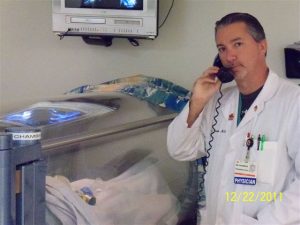
- Dr. Brian Paterick
We’ve all heard the mostly joking conjecture that an earthquake in California someday could make Arizonaa beachfront state. That’s the last thing Dr. Brian Paterick thinks about.
Using an evolving medical science to treat patients who, so far at least, remain safely landlocked is Paterick’s No. 1 motivation.
A board certified emergency room physician at Chandler Regional Medical Center, Paterick last month received certification in Undersea and Hyperbaric Medicine from the American Board of Emergency Medicine.
In addition to his role as an ER doctor, Paterick serves as medical director for the hospital’s Wound Healing and Hyperbaric Oxygen Center, which provides hyperbaric oxygen therapy to treat wounds that have not responded to traditional treatments. That same therapeutic measure is used, although only occasionally, to help patients who have gone diving and are suffering from decompression sickness, commonly known as “the bends.”
As Paterick explained, the origins of hyperbaric medicine date back to at least the late 1800s, when divers were helping to build the Brooklyn Bridge.
Many of the workers who spent time underwater creating the bridge’s supports suffered from muscle pain, a common symptom of decompression sickness. Paterick said the condition stems from nitrogen bubbles that form in the bloodstream while underwater and that do not properly dissipate if a diver comes back to the surface too quickly.
Eventually, medical researchers realized that if people with this condition were re-pressurized on land, mimicking the pressure they felt underwater, and then gradually had a reduction in pressure, the nitrogen bubbles would get out and the symptoms would go away.
Over time, Paterick said, this hyperbaric procedure was found to work on patients with hard-to-heal wounds, including diabetic foot ulcers, crushing injuries, and other problematic wounds.
“During hyperbaric treatment the patient is under pressure and breathing 100 percent oxygen, which causes more oxygen to dissolved in the bloodstream, allowing it to get to the wounds which are not getting enough oxygen.”
Originally called hyperbaric medicine, this treatment was then re-named undersea medicine but is now referred to as both, according to Paterick.
A member of the American College of Hyperbaric Medicine, the Divers Alert Network and the Undersea and Hyperbaric Medical Society, Paterick said he thoroughly enjoys working at the wound care center, which is the only one in Arizona accredited with distinction by the Undersea and Hyperbaric Medical Society.
Of the patients who come into the center for care, Paterick said, about 20 percent of them undergo hyperbaric treatment, and 92 percent of those recover in about 12 weeks.
Many of the patients Paterick works with have diabetes, which causes small blood vessels and capillaries to die off, meaning that, if the patient is injured, the wound tends to be stubborn and won’t heal properly.
Although the center is equipped to take care of divers, Paterick said the lack of an oceanfront environment in Arizona makes those cases pretty rare.
“We did care for a man once who went diving off Catalina (Island) and came in with symptoms of the bends,” he said.
“But a lot of doctors use the undersea component in coastal regions like San Diego, and in Louisiana where there are a lot of workers who work on the oil rigs, diving off the Gulf of Mexico.”
Paterick said he enjoys working both as an emergency room physician and at the wound care center. While both jobs are fulfilling and give him the opportunity to help people in need, working at the wound care center gives him the advantage of getting to know his patients, which is something that he really enjoys.
“In the emergency room I see them once, and that’s it. But at the wound care center, I see most of them every week for 2 to 3 months, and it’s nice to get to know them.”
After healing occurs, the patient is given an award and gets to ring a bell in celebration.
“We have a great team here helping our patients, including a great group of nurses,” he said. “The patients are motivated and thankful for the care.”

